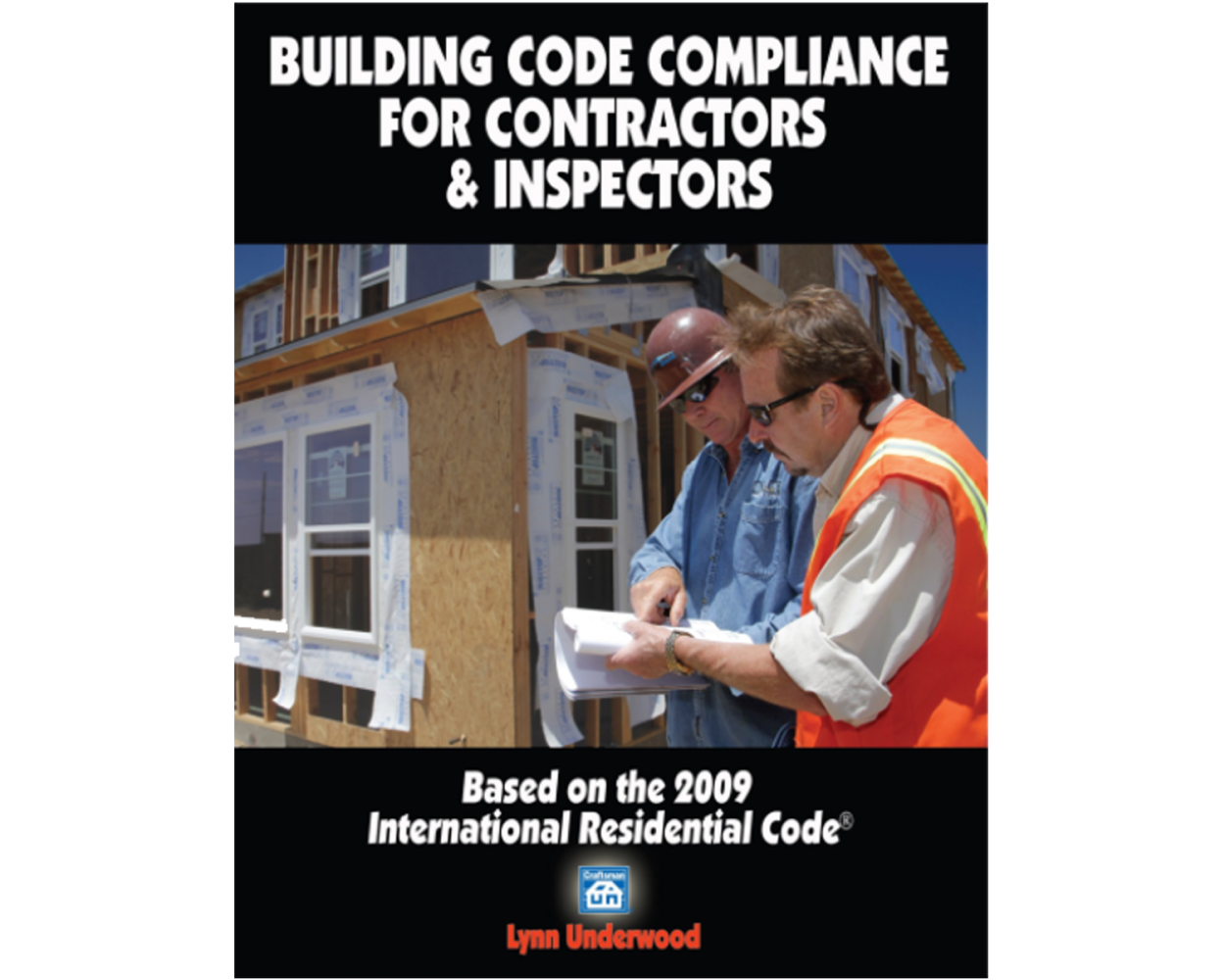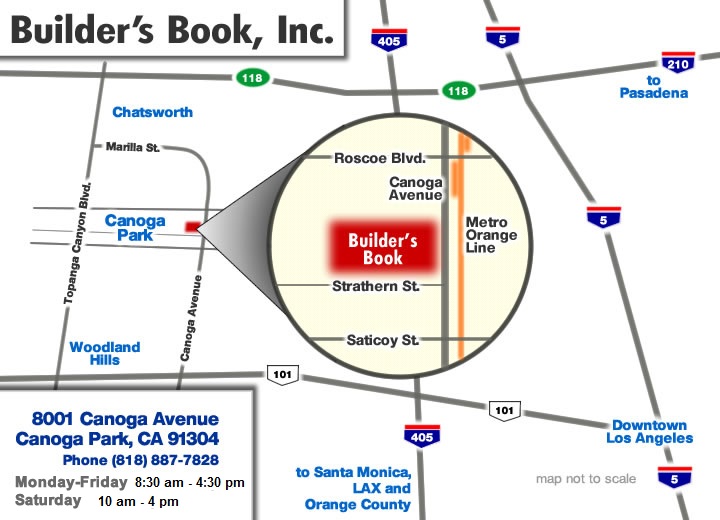Building Code Compliance for Contractors & Inspectors
Building Code Compliance for Contractors & Inspectors
A Cheat Sheet of Construction Inspection Tips
An answer book for both contractors and building inspectors, this manual explains what it takes to pass inspections under the 2009 International Residential Code.
Have you ever failed a code inspection? Have you ever dealt with an inspector who has his own personal interpretation of the Code and forces you to comply with it? If so, you'll love this book!
It includes a code checklist for every trade, covering some of the most common reasons why inspectors reject residential work - footings, foundations, slabs, framing, sheathing, plumbing, electrical, HVAC, energy conservation and final inspection.
Knowing in advance what the inspector wants to see gives contractors an (almost unfair) advantage. To pass inspection, just go down the checklists in this manual before the inspector arrives. Even better, use this manual as a guide to what constitutes good construction practice - and is almost certain to pass inspection.Building Code Compliance for Contractors & Inspectorswill be worth many times the cover price ...
- If your fingers are crossed every time an inspector walks on the job.
- If failed inspections are an embarrassing waste of time and money.
- If you want to build a reputation for professional-quality work.
- If you need to improve relations with code-enforcement personnel.
The author steps you through the entire permit process, item by item - permit processing, plan
, zoning, site development, all the codes (IRC, IBC, IPC, IMC, etc.), and rules recommend for both contractors and inspectors:
- Tips for developing good relations with the building inspector.
- What to do and what to avoid when your job doesn't pass inspection.
- What to do if you feel you're being treated unfairly (appeals).
- Where the inspector has latitude and when it doesn't pay to argue.
- Dozens of tips to ensure you pass the next inspection.
- Who to ask for at the building department when you need help.
But this is more than a guide to code-compliance. It's also a handbook for building inspectors and anyone interested in a code enforcement career. The author explains how to qualify yourself for a job at the local building department, how to sail through the examination and interview process, and what it takes to be an effective code enforcement official.
If your work requires getting permits and passing inspections, put this manual to work on your next job. Sample Scenario: A homeowner calls in the wee hours and claims his water heater needs replacing. First thing next morning you go pay the permit fee, and your sub installs the new tank. You call for an inspection but can't be there when the inspector comes. The inspector comes out, and leaves a note claiming he can't tell if the discharge tubing from the pressure relief valve was installed correctly. You have no idea how the PTR tubing was installed either...because it is hidden within the walls and floor system. Now what? Are you going to have to tear out drywall and flooring to prove that the tube discharges in a proper manner to an approved location?
Section 504 of the International Plumbing Code and Section P2803 of the International Residential Code speaks to NEW installations, not necessarily replacement units or repair of existing equipment. For replacement of water heaters you can't be expected to install a new discharge line within the wall and floor framing. However, the inspector is right to question this installation. Because if the water heater began overheating and the PTR blew...that would mean that superheated water would be released ... somewhere. That type of danger is always on the mind of the inspector.
But there are some things that are not reasonable to expect. Opening up walls and floor decking to inspect discharge tubing is not reasonable, especially if there are other means of determining compliance with the intent of the code...and there usually are. The simplest thing to do is to trip the PTR mechanism and look around for the water discharge. That would be the very best way to satisfy the inspector that the discharge was to a proper location.
Another reminder: The 2009 editions of both codes have 13 conditions for the discharge pipe that must be met on new installations. Some of them can be retrofitted without much effort. Where that is possible, it is reasonable for the inspector to ask for some of these upgrades. Remember, the inspector's job is to improve safety as much as possible within the limits of the code itself. About the Author: Lynn Underwood is Chief Building Official for Norfolk, Virginia. He has been a code enforcement official for nearly 30 years, holds a dozen certifications, including plans examiner, building, plumbing, mechanical and electrical inspector, and has conducted hundreds of on-site inspections. There's lifetime of code-compliance and enforcement savvy between the covers of this manual. By: Lynn Underwood Published by: Craftsman Book Company ISBN: 978-1-57218-238-7/1572182385 232 Pages, 8-1/2 x 11 Includes: Book
| Price | $32.50 |
|---|---|
| Customer Service | Customer ServiceWe're Here To Help Call us anytime during our customer service hours... Monday through Friday - 8:30 am to 4:30 pm (Pacific) Order Questions: TOLL FREE, 800-273-7375 (Outside the U.S. call 818-887-7828). Our Address: 8001 Canoga Avenue Canoga Park, CA 91304 US Phone: 800-275-2665 E-mail: sales@buildersbook.com
|
| Description | Building Code Compliance for Contractors & Inspectors A Cheat Sheet of Construction Inspection Tips An answer book for both contractors and building inspectors, this manual explains what it takes to pass inspections under the 2009 International Residential Code. Have you ever failed a code inspection? Have you ever dealt with an inspector who has his own personal interpretation of the Code and forces you to comply with it? If so, you'll love this book! It includes a code checklist for every trade, covering some of the most common reasons why inspectors reject residential work - footings, foundations, slabs, framing, sheathing, plumbing, electrical, HVAC, energy conservation and final inspection. Knowing in advance what the inspector wants to see gives contractors an (almost unfair) advantage. To pass inspection, just go down the checklists in this manual before the inspector arrives. Even better, use this manual as a guide to what constitutes good construction practice - and is almost certain to pass inspection.Building Code Compliance for Contractors & Inspectorswill be worth many times the cover price ...
The author steps you through the entire permit process, item by item - permit processing, plan , zoning, site development, all the codes (IRC, IBC, IPC, IMC, etc.), and rules recommend for both contractors and inspectors:
But this is more than a guide to code-compliance. It's also a handbook for building inspectors and anyone interested in a code enforcement career. The author explains how to qualify yourself for a job at the local building department, how to sail through the examination and interview process, and what it takes to be an effective code enforcement official. If your work requires getting permits and passing inspections, put this manual to work on your next job. Sample Scenario: A homeowner calls in the wee hours and claims his water heater needs replacing. First thing next morning you go pay the permit fee, and your sub installs the new tank. You call for an inspection but can't be there when the inspector comes. The inspector comes out, and leaves a note claiming he can't tell if the discharge tubing from the pressure relief valve was installed correctly. You have no idea how the PTR tubing was installed either...because it is hidden within the walls and floor system. Now what? Are you going to have to tear out drywall and flooring to prove that the tube discharges in a proper manner to an approved location? Section 504 of the International Plumbing Code and Section P2803 of the International Residential Code speaks to NEW installations, not necessarily replacement units or repair of existing equipment. For replacement of water heaters you can't be expected to install a new discharge line within the wall and floor framing. However, the inspector is right to question this installation. Because if the water heater began overheating and the PTR blew...that would mean that superheated water would be released ... somewhere. That type of danger is always on the mind of the inspector. But there are some things that are not reasonable to expect. Opening up walls and floor decking to inspect discharge tubing is not reasonable, especially if there are other means of determining compliance with the intent of the code...and there usually are. The simplest thing to do is to trip the PTR mechanism and look around for the water discharge. That would be the very best way to satisfy the inspector that the discharge was to a proper location. Another reminder: The 2009 editions of both codes have 13 conditions for the discharge pipe that must be met on new installations. Some of them can be retrofitted without much effort. Where that is possible, it is reasonable for the inspector to ask for some of these upgrades. Remember, the inspector's job is to improve safety as much as possible within the limits of the code itself. About the Author: Lynn Underwood is Chief Building Official for Norfolk, Virginia. He has been a code enforcement official for nearly 30 years, holds a dozen certifications, including plans examiner, building, plumbing, mechanical and electrical inspector, and has conducted hundreds of on-site inspections. There's lifetime of code-compliance and enforcement savvy between the covers of this manual. By: Lynn Underwood Published by: Craftsman Book Company ISBN: 978-1-57218-238-7/1572182385 232 Pages, 8-1/2 x 11 Includes: Book |


